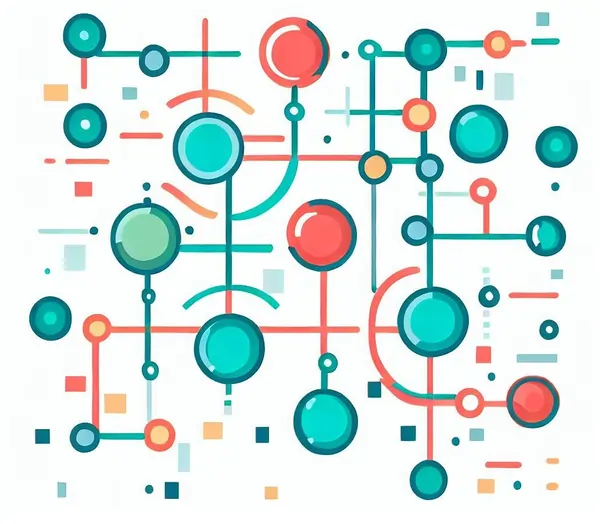Markov Chains: Fundamentals and Applications

Markov chains, a concept that finds its roots in probability theory and mathematical modeling, have emerged as a powerful tool in various fields, from finance and engineering to biology and computer science. In this comprehensive guide, we will delve into the fundamentals of Markov chains and explore their diverse applications, helping you complete your probability theory assignment.
Understanding Markov Chains
At its core, a Markov chain is a mathematical model used to describe a sequence of events or states in a system. The central idea behind a Markov chain is that the probability of transitioning from one state to another only depends on the current state and not on the sequence of events that preceded it. This property is known as the Markov property or the memory lessness property
In other words, the future behavior of the system is independent of its past behavior, given its present state. This makes Markov chains particularly useful for modeling systems that exhibit a certain level of randomness or unpredictability.

Components of a Markov Chain
- States (S):
- Transition Probabilities (P):
- Time Steps (n):
- Initial State (π):
States are fundamental building blocks in the Markov chain framework. They represent the different conditions or situations that a system can be in at any given time. States can be discrete or continuous, depending on the nature of the system being modeled.
Discrete States: In many applications, states are discrete and can be enumerated explicitly. For example, in a weather forecasting model, as mentioned earlier, the states could be "sunny," "cloudy," "rainy," "snowy," and so on. Each state represents a specific weather condition.
Continuous States: In some cases, states are continuous and can take on a range of numerical values. For instance, in modeling temperature variations, the states could be represented as a continuous range of temperature values.
The choice of how states are defined depends on the problem at hand and the level of detail required in the model. The accuracy of a Markov chain model often relies on the appropriate characterization of states.
Transition probabilities are a critical aspect of Markov chains. They determine the likelihood of moving from one state to another during a single time step or iteration. These probabilities are typically organized into a transition probability matrix, often denoted as P.
Transition Probability Matrix: The transition probability matrix P is a square matrix, where the rows and columns correspond to the states in the system. Each entry in this matrix represents the probability of transitioning from one state to another in one time step.
For a discrete Markov chain with n states, the transition probability matrix P will have dimensions n x n. Each row of the matrix sums to 1, ensuring that the probabilities of all possible state transitions from a given state add up to 1.
Markov chains evolve over discrete time steps or iterations. These time steps represent the progression of the system from one state to another. The choice of the time step size can vary based on the specific application.
Time Step Interpretation: Each time step corresponds to a unit of time, which could be minutes, hours, days, or any other relevant interval. The system's state at a given time step depends on its previous state and the transition probabilities defined in the transition probability matrix.
The evolution of the Markov chain is often described as a sequence of transitions over time, and the behavior of the system is observed at discrete points in time.
The initial state, denoted as π, represents the system's state at the very beginning of the Markov chain process. It serves as the starting point for the chain. The choice of the initial state can significantly impact the behavior and outcomes of the Markov chain.
Initial State Assignment: The assignment of the initial state depends on the specific problem and the initial conditions of the system being modeled. In some cases, the initial state may be chosen randomly, while in others, it may be determined based on prior knowledge or observations.
The initial state sets the initial conditions for the Markov chain, and from there, the chain evolves through time steps as governed by the transition probabilities. Over time, as the chain progresses, it may reach a steady-state distribution where the system's state probabilities stabilize.
Transition Probability Matrix
The transition probability matrix P is a fundamental element of Markov chains. It summarizes all the possible state transitions and their associated probabilities. In a discrete Markov chain with n states, the transition probability matrix is an n x n matrix, where each row represents the current state, and each column represents the next state.
Markov Chain Properties
Markov chains exhibit several important properties:
- Stationary (Steady-State) Distribution:
- Convergence: For a Markov chain to have a stationary distribution, it must satisfy certain conditions. One critical condition is that the chain must be both irreducible and aperiodic (conditions discussed below).
- Invariance: In the stationary distribution, the probabilities of being in different states remain constant across successive time steps. This means that if the chain reaches its stationary distribution, the state probabilities no longer change with time.
- Stability: The stationary distribution represents a state of stability for the Markov chain. Once the chain reaches this state, it remains there indefinitely unless external factors disrupt it.
- Applications: Stationary distributions are often used to analyze long-term behavior in applications such as finance (e.g., predicting long-term stock market trends), epidemiology (e.g., modeling disease spread over extended periods), and climate science (e.g., studying long-term climate patterns).
- Irreducibility:
- Connectivity: An irreducible Markov chain is connected, meaning that it forms a single, interconnected system. There are no isolated components or states that are unreachable from certain starting states.
- Accessibility: Irreducibility ensures that, given enough time steps, any state can be reached from any other state with a positive probability.
- Practical Implications: Irreducibility is crucial for ensuring that a Markov chain accurately models real-world systems where transitions between different states are possible. It ensures that the chain can explore the entire state space and does not get "stuck" in a subset of states.
- Applications: Irreducible Markov chains are commonly used in fields such as physics (e.g., modeling particle interactions), social sciences (e.g., studying social networks), and operations research (e.g., analyzing transportation systems).
- Aperiodicity:
- Regular vs. Aperiodic Chains: Regular chains exhibit a periodic behavior where they return to certain states at fixed time intervals. Aperiodic chains, on the other hand, lack this regularity, and the time between returns to a given state is not fixed.
- Realistic Modeling: Aperiodic chains are often preferred for modeling real-world systems because they better reflect the unpredictable nature of many processes.
- Practical Applications: Aperiodicity is essential in fields like queuing theory (e.g., analyzing service systems), cryptography (e.g., random number generation), and computer science (e.g., designing algorithms with unpredictable behavior).
- Implications for Stationary Distribution: Aperiodicity is a prerequisite for the existence of a stationary distribution. In periodic chains, a true stationary distribution may not exist.
The stationary distribution, also known as the steady-state distribution or equilibrium distribution, is a crucial property of Markov chains. It describes the long-term behavior of the system as the number of time steps approaches infinity. In essence, it represents the distribution of states that the Markov chain tends to stabilize around over time.
Key Points:
Irreducibility is a property of Markov chains that ensures the chain can transition from any state to any other state, either directly or through a sequence of transitions. In other words, there are no isolated subsets of states within the chain that cannot be reached from one another.
Key Points:
Aperiodicity is a property that describes the absence of a regular, repeating pattern in the transitions of a Markov chain. In other words, it indicates that the chain does not return to the same state at fixed intervals.
Key Points:
Applications of Markov Chains
Now that we've covered the fundamentals of Markov chains, let's explore their diverse range of applications across various fields:
- Finance
- Stock Market Analysis:Markov chains are used to model and predict stock price movements. Traders and investors can make informed decisions based on the probabilities of different market states.
- Credit Risk Assessment:Banks and financial institutions employ Markov chains to assess the credit risk of customers. This helps determine whether a borrower will default on a loan.
- Engineering
- Reliability Engineering:In engineering, Markov chains are used to model the reliability of complex systems, such as electrical grids and transportation networks. This helps identify potential failure points and optimize maintenance schedules.
- Quality Control:Manufacturers use Markov chains to analyze and improve quality control processes. By modeling the transitions between defective and non-defective states, they can reduce defects in production.
- Biology
- Genetics and Molecular Biology:Markov models are employed to study DNA sequences and protein folding. They help uncover hidden patterns in genetic data and predict molecular behavior.
- Epidemiology:Epidemiologists use Markov models to track the spread of diseases in populations. These models consider the transitions between healthy, infected, and recovered states.
- Natural Language Processing (NLP)
- Speech Recognition:Markov models are used in speech recognition systems to predict the next word in a sentence based on the current word and context. This is crucial for applications like voice assistants.
- Part-of-Speech Tagging:In NLP, Markov models can be applied to part-of-speech tagging, where words are assigned grammatical categories based on the probability of transitions between word categories.
- Computer Science
- PageRank Algorithm:Google's PageRank algorithm, which determines the relevance of web pages in search results, uses a Markov chain to model the probability of a user jumping from one page to another by following links.
- Hidden Markov Models (HMMs):HMMs are used in various applications, including speech recognition, bioinformatics, and natural language processing, to model sequences with hidden states.
- Gaming and Simulations
- Board Games:Markov chains are used in board games like chess to model possible future game states and aid in decision-making for players and AI opponents.
- Monte Carlo Simulations: In simulations and game design, Markov chains are employed to model probabilistic events, allowing for more realistic and dynamic game experiences.
- Climate Science
- Climate Modeling:Markov models are used to simulate and predict climate patterns and transitions between different climate states, aiding in climate change research and weather forecasting.
- Social Sciences
- Sociology: Markov models are utilized in social sciences to study various phenomena, such as social mobility, employment transitions, and voting behavior.
- Internet of Things (IoT)
- Predictive Maintenance:In IoT applications, Markov models are employed to predict the maintenance needs of connected devices and machinery, reducing downtime and maintenance costs.
Conclusion
Markov chains, with their ability to model systems characterized by randomness and uncertainty, have found applications in a wide range of fields. By understanding the fundamental principles of Markov chains, including states, transition probabilities, and stationary distributions, you can harness their power to analyze, predict, and optimize processes and systems in diverse domains. Whether you're a data scientist, engineer, biologist, or game designer, Markov chains offer a versatile toolset to tackle complex problems and make informed decisions. As technology continues to advance, the applications of Markov chains are likely to expand, offering new insights and solutions in an ever-evolving world.